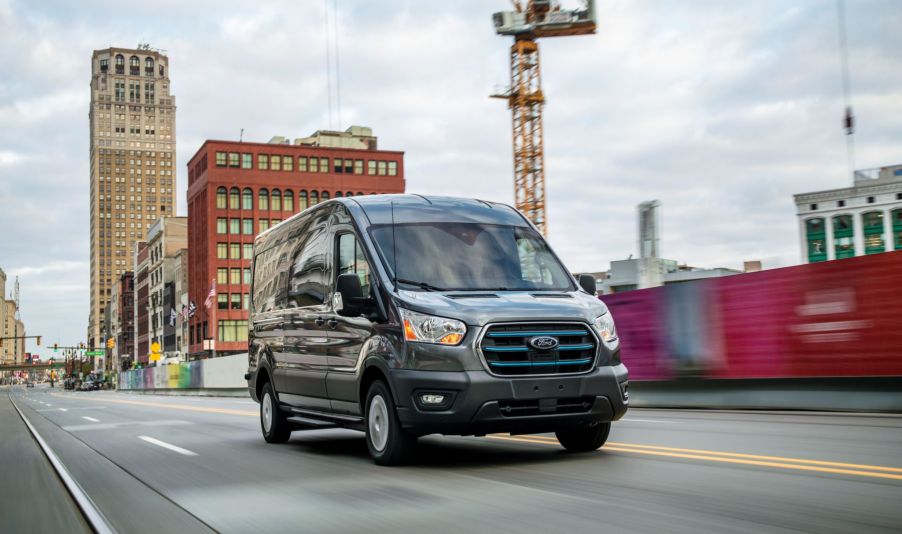
2022 Ford E-Transit Absolutely Embarrasses the Much More Expensive Mercedes-Benz eSprinter
The Ford Transit has been one of the best-selling U.S. commercial van brands in the market, trumping competitors like the Chevrolet Express and Ram ProMaster in sales. Consequently, Ford’s introduction of the Ford E-Transit is not surprising given the general shift for car manufacturers into EVs. Like other versions of the Ford Transit, it’s meant to cater to cargo and passengers, and its features don’t disappoint.
That said, the E-Transit is an early entrant into the market, with competition expected to grow. Other electric van models that should be hitting roads soon include the Rivian Amazon Prime van. However, for the time being, the only open competition is the Mercedes-Benz eSprinter, which is seemingly much worse but with a significantly higher price tag. Here’s a brief look at how the two electric vans compare.
2022 Ford E-Transit

The 2022 Ford E-Transit electric vehicle’s pricing starts at between $43,000 and $44,000 for the cutaway and chassis cab options. The cargo van is a bit more expensive, starting at about $47,185, although you won’t have to worry about the costs of customizing the body. All vehicle models come with a 68 kWh battery fitted below the van to maximize the cargo space available.
Ford claims to have collated 30 million miles of data from Ford Pro Telematics. It used this data to average the daily range for commercial vans and found it to be 74 miles. Since it expects some users to go well above this mark, Ford designed the E-transit with a 126-mile maximum range.
The electric van provides seating for two at the front and a maximum payload of 3,880 lbs if you choose the regular-length low roof option. However, the range and the payload may decrease if you select a lengthier option or a higher roof. On the other hand, choosing a longer vehicle or a higher roof increases the cargo volume.
As for the performance metrics, the Ford E-Transit’s drivetrain can produce 266 horsepower and 317 lb-ft of torque. You can also charge the battery from 15-80% in 34 minutes at a direct-current fast charger charging station. If you’re charging at home using either a 48A 240V L2 or a 30A 240V L2 charger, the charging times from 0-100% are eight hours and 12 hours, respectively.
Mercedes-Benz eSprinter
As for the Mercedes Benz eSprinter, pricing starts at about £52,000 (roughly $68,243), according to Driving Electric. Since it only comes in a single body style, prices don’t vary much from the starting point. Also, with the eSprinter, you can get either 47 kWh or 35 kWh usable battery capacity options.
The lower battery capacity means the driving range is a lot shorter, maxing out at about 115 kilometers (roughly 93 miles), according to Mercedes-Benz. Nevertheless, it’s intended for last-mile deliveries in cities with shorter travel distances.
There’s a three-seater cabin upfront, and payload varies depending on the battery capacity. This is due to the higher-capacity batteries being bigger and heavier than their counterparts. Consequently, the 47 kWh option has a 900 kilogram (roughly 1,984 lbs) capacity, while the 35 kWh alternative has a 1,040 kilogram (roughly 2,293 lbs) capacity.
You see a similar trend regarding performance, where the Mercedes-Benz eSprinter produces an equivalent of 116 horsepower and 217 lb-ft of torque. However, since the batteries are smaller, they charge a lot faster than the Ford’s, with rapid charging for the 35 kWh option taking 20 minutes to go from 10-80%. With an upgraded charger, charging at home should take eight hours from 0-100%.
Other E-Transit electric van competitors
Other electric vans are expected to hit markets soon, including options like Oshkosh Defense electric postal trucks, Bollinger electric commercial vehicles, and the Rivian Amazon Prime van, according to MotorTrend. According to Mercedes-Benz, there’s even a newer version of the Mercedes-Benz eSprinter expected in 2023, and it’s poised to give the Ford E-transit a much better run for its money.


